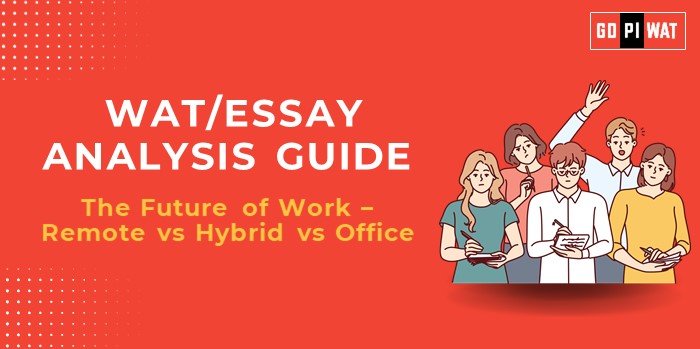📋 The Future of Work – Remote vs Hybrid vs Office
🌐 Understanding “The Future of Work” Importance
This topic is crucial as it explores how work models impact efficiency, employee satisfaction, and corporate success. Given the evolving nature of workplace trends, the debate holds significant implications for B-school students focused on human resources, strategy, and technology management.
📝 Effective Planning and Writing
- ⏱️ Time Allocation: Planning (5 minutes), Writing (20 minutes), Review (5 minutes).
- 📊 Preparation Tips: Focus on recent statistics and trends in different work models. Outline the roles of employers, employees, and regulators in shaping work environments.
💡 Introduction Techniques for Essays
Consider using contrasting or solution-oriented approaches to introduce your essay:
- Contrast Approach: “While remote work offers unparalleled flexibility, office settings support faster collaboration and culture-building—a delicate balance that companies now navigate.”
- Solution-Based Approach: “The future of work lies in finding the ideal mix between remote, hybrid, and office models, where efficiency and work-life balance converge.”
📚 Structuring the Essay Body
Organize your essay with key themes:
- Achievements: Discuss improvements in work-life balance, cost efficiency, and productivity using remote and hybrid models.
- Challenges with Comparative Analysis: Describe the drawbacks of each model, e.g., the isolation in remote work or reduced flexibility in office work, with examples from industries.
- Future Outlook: Predict how organizations may adopt dynamic or hybrid work environments with ongoing technological and regulatory advancements.
🎯 Concluding Effectively
Here are some approaches to concluding your essay:
- Balanced Perspective Conclusion: “A balanced approach, blending remote, hybrid, and in-office models, may best address the needs of both employers and employees in a post-pandemic world.”
- Global Comparison Conclusion: “Countries like the Netherlands, with high remote work adoption, highlight the benefits of flexibility, while Japan’s cautious approach shows the challenges of shifting deeply embedded work cultures.”
📊 Analyzing Successes and Shortcomings
Key Achievements: Improved flexibility, enhanced work-life balance, and expanded hiring capabilities.
Ongoing Challenges: Risks of isolation, decreased team cohesion, and increased digital security concerns.
Global Context: Examine countries with progressive remote work policies (e.g., the Netherlands) versus those that prefer traditional work models (e.g., Japan).
🔧 Recommendations for Sustainable Progress
- 🎯 Tailored Work Models: Companies should customize models based on specific roles and individual preferences.
- 💻 Invest in Digital Infrastructure: Reliable digital tools are essential to maintain productivity and engagement.
- 🔒 Data Security Measures: Strengthening cybersecurity is critical for remote and hybrid setups.
✍️ Sample Short Essays on “The Future of Work”
Here are some examples of short essay perspectives:
- Balanced Perspective: “The future of work likely requires a flexible blend of remote and office environments, aligning productivity with work-life balance. This hybrid approach empowers employees while retaining essential aspects of in-office collaboration.”
- Solution-Oriented: “As technology advances, the hybrid model may become the most effective, combining remote efficiency with the collaborative strength of the office. Businesses should focus on policies that balance flexibility with team cohesion.”
- Global Comparison: “Globally, work trends vary—countries like the Netherlands favor remote models, while Japan remains office-oriented. By analyzing these approaches, organizations can better determine the optimal work model for their context.”


